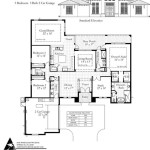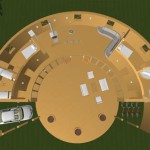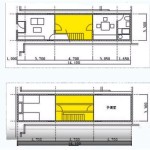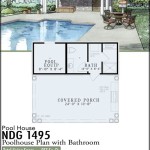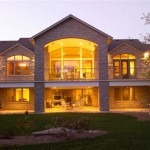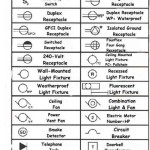1.5 Story House Plans With Walkout Basement: Maximizing Space and Terrain
The combination of a 1.5 story house plan with a walkout basement presents a compelling design solution for homeowners seeking to maximize living space while effectively utilizing sloping terrain. This architectural approach blends the visual appeal and functional benefits of both design elements, resulting in a home that is both aesthetically pleasing and highly practical. Understanding the nuances of this design style is crucial for anyone considering building or renovating a home.
The defining characteristic of a 1.5 story house is its upper level, which is typically smaller than the main level and housed within the roof structure. This design creates distinctive rooflines and often features dormer windows to provide light and ventilation to the upper rooms. The walkout basement, on the other hand, leverages a sloping lot to create a lower level that is partially or fully above ground, allowing for direct access to the outdoors. Integrating these two elements requires careful planning and consideration of various factors, including site conditions, local building codes, and homeowner preferences.
Integrating the 1.5 Story Design
The 1.5 story design offers several advantages, primarily related to space utilization and aesthetics. The reduced upper-level footprint minimizes the overall building height, often making it a more suitable choice for areas with height restrictions. The characteristic sloped rooflines create a charming and visually interesting exterior. Furthermore, the reduced floor space on the upper level can lead to more efficient heating and cooling, potentially resulting in energy savings.
However, the design also presents some challenges. The sloped ceilings in the upper level can limit headroom in certain areas, requiring careful space planning to ensure comfortable living spaces. Dormer windows are essential for providing adequate light and ventilation, but their design and placement must be carefully considered to maintain architectural harmony and avoid potential weatherproofing issues. Finally, access to the upper level often involves a staircase, which can pose challenges for individuals with mobility issues.
When incorporating a 1.5 story design, consideration should be given to the layout of the main level. Typically, the main level houses the primary living areas, such as the living room, kitchen, and dining room, as well as the master bedroom suite. The upper level is often used for additional bedrooms, bathrooms, and possibly a secondary living area or home office. The placement of the staircase to the upper level should be strategically located to minimize disruption to the main level's layout and to provide convenient access to the upper rooms.
Leveraging the Walkout Basement
The addition of a walkout basement significantly enhances the functionality and value of a 1.5 story home. By taking advantage of a sloping lot, the walkout basement provides additional living space that is partially or fully above ground, offering unique opportunities for natural light and direct access to the outdoors. This design element effectively transforms a potentially unusable below-grade space into a valuable and versatile area.
A walkout basement can be used for a variety of purposes, including a recreation room, home theater, additional bedrooms and bathrooms, a home office, or even a separate apartment for rental income or extended family living. The direct access to the outdoors via sliding glass doors or a patio provides a seamless connection between the indoor and outdoor spaces, making it an ideal location for entertaining or relaxing.
Designing a functional and comfortable walkout basement requires careful attention to several key factors. Proper drainage is essential to prevent moisture problems and ensure the long-term durability of the structure. Adequate insulation is necessary to maintain a comfortable temperature and minimize energy costs. Natural light can be maximized through the use of large windows and sliding glass doors. Furthermore, the layout of the basement should be carefully planned to ensure efficient use of space and to accommodate the desired functions.
The integration of a walkout basement also requires compliance with local building codes and regulations. These codes may specify requirements for egress windows, fire-rated walls, and other safety features. It is essential to consult with a qualified architect or builder to ensure that the design meets all applicable codes and regulations.
Key Considerations for Combined Design
Combining the 1.5 story design with a walkout basement requires careful consideration of several critical aspects. The integration of these two design elements must be seamless to create a cohesive and functional home. These considerations span site analysis, structural integrity, access and egress planning, and aesthetic harmonization.
Site Analysis and Grading: The slope of the lot is a critical factor in determining the feasibility and design of a walkout basement. A gentle slope is ideal, allowing for a gradual transition between the main level and the basement. A steeper slope may require more extensive excavation and retaining walls, which can increase construction costs. Furthermore, the site's soil conditions and drainage patterns must be carefully analyzed to ensure the long-term stability and dryness of the basement. Proper grading is essential to direct water away from the foundation and prevent water damage.
Structural Integrity and Foundation Design: The foundation of a 1.5 story house with a walkout basement must be designed to withstand the forces of the surrounding soil and water. This typically involves the use of reinforced concrete walls and footings. The foundation design must also account for the weight of the structure above, as well as any potential seismic activity in the area. Proper waterproofing is essential to prevent moisture from penetrating the foundation walls. Additionally, the design must consider the impact of the walkout opening on the structural integrity of the foundation. The foundation must be adequately reinforced to compensate for the removal of soil and the creation of the opening.
Access and Egress Planning: The design must provide safe and convenient access to all levels of the home. The staircase to the upper level should be centrally located and easily accessible from the main living areas. The walkout basement should have direct access to the outdoors via sliding glass doors or a patio. Furthermore, the design must meet all applicable building codes for egress windows and emergency exits. Egress windows are required in all bedrooms and habitable spaces in the basement to provide a means of escape in the event of a fire. The design should also consider the needs of individuals with mobility issues, providing ramps or other accessible features where necessary.
Aesthetic Harmonization and Material Selection: The exterior design of the 1.5 story house with a walkout basement should be cohesive and visually appealing. The materials used for the exterior siding, roofing, and trim should complement each other and create a harmonious aesthetic. The design should also consider the surrounding landscape and incorporate natural elements where possible. For example, stone or brick accents can be used to integrate the basement walls with the natural terrain. The design of the dormer windows should be carefully considered to ensure that they are proportionally sized and aesthetically pleasing. Furthermore, the design of the walkout area should be integrated with the overall architectural style of the house.
Energy Efficiency Considerations: Designing an energy-efficient 1.5 story house with a walkout basement requires careful attention to insulation, ventilation, and window placement. Proper insulation in the walls, roof, and foundation can significantly reduce heating and cooling costs. Energy-efficient windows and doors can also help to minimize heat loss and gain. Adequate ventilation is essential for maintaining indoor air quality and preventing moisture problems. The placement of windows and doors should be carefully considered to maximize natural light and minimize solar heat gain in the summer. Furthermore, the design should incorporate passive solar heating and cooling strategies where possible. For example, south-facing windows can be used to capture solar heat in the winter, while overhangs can be used to shade windows in the summer.
In conclusion, designing a 1.5 story house with a walkout basement is a complex but rewarding undertaking. By carefully considering the various factors outlined above, homeowners can create a beautiful, functional, and energy-efficient home that maximizes the use of their property and provides a comfortable living space for years to come. Collaboration with experienced architects, builders, and engineers is essential to ensure a successful project.

Small Cottage Plan With Walkout Basement Floor

Rustic Mountain House Floor Plan With Walkout Basement Plans Ranch Style

Cost Effective Craftsman House Plan On A Walkout Basement 25683ge Architectural Designs Plans

Small Cottage Plan With Walkout Basement Floor

Don Gardner Walkout Basement House Plans Blog Eplans Com

Walkout Basement House Plans To Maximize A Sloping Lot Houseplans Blog Com

Don Gardner Walkout Basement House Plans Blog Eplans Com

Walkout Basement House Plans With Photos From Don Gardner Houseplans Blog Com

Modern Farmhouse Plan W Walkout Basement Drummond House Plans

Modern Prairie Style House Plan With Loft Overlook And Finished Walkout Basement 890130ah Architectural Designs Plans

